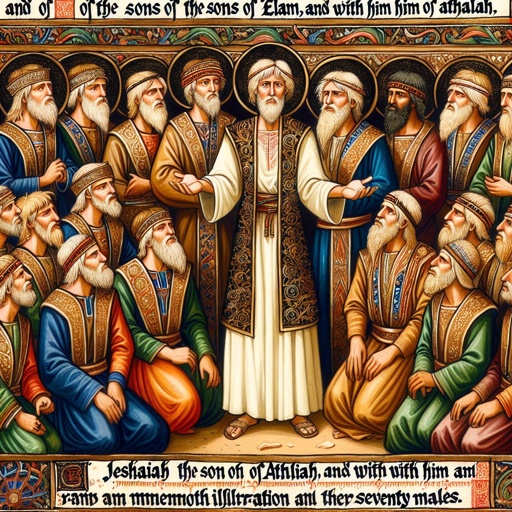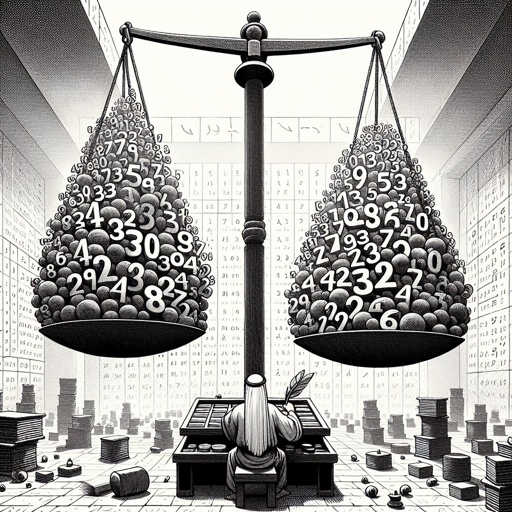What does Ezra 8:9 mean?
"Of the sons of Joab; Obadiah the son of Jehiel, and with him two hundred and eighteen males." - Ezra 8:9

Ezra 8:9 - "Of the sons of Joab; Obadiah the son of Jehiel, and with him two hundred and eighteen males."
An interpretation of the biblical verse, Ezra 8:9. Depict a scene featuring Obadiah, a Middle-Eastern male, recognizing him as the son of Jehiel. He should be surrounded by two hundred and eighteen males of a mixed range of descents including Caucasian, Hispanic, Black, South Asian, and others. The artistry should convey a modern touch to the ancient setting. Use a vibrant palette, play with the contrast of light and shadows, and use broad and clear lines to create the digital art effect.
Ezra 8:9 in the King James Version reads, "Of the sons of Joab; Obadiah the son of Jehiel, and with him two hundred and eighteen males." This verse is part of a longer list of names in the book of Ezra, which records the genealogy and account of those who returned from exile in Babylon to Jerusalem. The book of Ezra is a historical account of the return of the exiles to Jerusalem and the rebuilding of the temple, detailing the challenges and triumphs of the Jewish people as they sought to reestablish their homeland and religious practices.
The verse in question may seem insignificant at first glance, but it is part of a larger narrative that is integral to the overall themes of the book of Ezra. One of the main themes in Ezra is the importance of keeping genealogical records and maintaining the identity and lineage of the Jewish people. This emphasis on genealogy serves to establish the legitimacy and continuity of the Jewish people, reinforcing their connection to the land of Israel and their religious heritage. The meticulous enumeration of the sons of Joab, including Obadiah and the 218 males who returned from exile, underscores the significance of each individual in the grander narrative of the Jewish community.
Furthermore, the verse highlights the concept of collective responsibility and communal identity within the Jewish community. The inclusion of the 218 males alongside Obadiah emphasizes the unity and solidarity of the exiles as they returned to their homeland. Each individual was essential to the preservation and continuation of the Jewish people, and their collective return symbolized the strength and resilience of the community as a whole.
Symbolically, the verse also represents the idea of remembrance and continuity. By meticulously recording the names and numbers of those who returned from exile, the book of Ezra emphasizes the importance of remembering and honoring the past. This serves as a reminder to the Jewish people of their history and heritage, ensuring that their journey from exile to return is not forgotten. The verse also underscores the continuity of the Jewish people, as the return from exile represents a pivotal moment in their history that laid the groundwork for future generations.
In a broader context, the inclusion of this verse within the book of Ezra aligns with the larger biblical theme of redemption and restoration. The return from exile to Jerusalem symbolizes a new beginning for the Jewish people, as they sought to rebuild their lives and reestablish their religious practices. This narrative of redemption and restoration is a recurring theme throughout the Bible, and the book of Ezra serves as a testament to the enduring faith and perseverance of the Jewish people in the face of adversity.
In conclusion, Ezra 8:9 may seem like a simple enumeration of names and numbers, but it carries deep thematic and symbolic significance within the larger context of the book of Ezra and the Bible as a whole. This verse underscores the importance of genealogy, collective responsibility, and communal identity within the Jewish community, while also symbolizing remembrance, continuity, and the themes of redemption and restoration. As part of the larger narrative of the return from exile, this verse serves as a powerful reminder of the resilience and faith of the Jewish people, and their enduring connection to the land of Israel and their religious heritage.
Ezra 8:9 Artwork

Ezra 8:9 - "Of the sons of Joab; Obadiah the son of Jehiel, and with him two hundred and eighteen males."

Ezra 8:8 - "And of the sons of Shephatiah; Zebadiah the son of Michael, and with him fourscore males."

Ezra 2:9 - "The children of Zaccai, seven hundred and threescore."

Ezra 8:32 - "And we came to Jerusalem, and abode there three days."

Ezra 2:8 - "The children of Zattu, nine hundred forty and five."

Ezra 8:7 - "And of the sons of Elam; Jeshaiah the son of Athaliah, and with him seventy males."

Ezra 8:6 - "Of the sons also of Adin; Ebed the son of Jonathan, and with him fifty males."

Ezra 8:12 - "And of the sons of Azgad; Johanan the son of Hakkatan, and with him an hundred and ten males."

Ezra 8:19 - "And Hashabiah, and with him Jeshaiah of the sons of Merari, his brethren and their sons, twenty;"

Ezra 8:23 - "So we fasted and besought our God for this: and he was intreated of us."

Ezra 7:8 - "And he came to Jerusalem in the fifth month, which was in the seventh year of the king."

Ezra 8:14 - "Of the sons also of Bigvai; Uthai, and Zabbud, and with them seventy males."

Ezra 8:34 - "By number and by weight of every one: and all the weight was written at that time."

Ezra 8:10 - "And of the sons of Shelomith; the son of Josiphiah, and with him an hundred and threescore males."

Ezra 8:5 - "Of the sons of Shechaniah; the son of Jahaziel, and with him three hundred males."

Ezra 8:4 - "Of the sons of Pahath-moab; Elihoenai the son of Zerahiah, and with him two hundred males."

Ezra 8:11 - "And of the sons of Bebai; Zechariah the son of Bebai, and with him twenty and eight males."

Ezra 8:2 - "Of the sons of Phinehas; Gershom: of the sons of Ithamar; Daniel: of the sons of David; Hattush."

Ezra 8:13 - "And of the last sons of Adonikam, whose names are these, Eliphelet, Jeiel, and Shemaiah, and with them threescore males."

Ezra 8:24 - "¶ Then I separated twelve of the chief of the priests, Sherebiah, Hashabiah, and ten of their brethren with them,"

Nehemiah 8:9 - "¶ And Nehemiah, which is the Tirshatha, and Ezra the priest the scribe, and the Levites that taught the people, said unto all the people, This day is holy unto the LORD your God; mourn not, nor weep. For all the people wept, when they heard the words of the law."

Ezra 8:3 - "Of the sons of Shechaniah, of the sons of Pharosh; Zechariah: and with him were reckoned by genealogy of the males an hundred and fifty."

Ezra 9:8 - "And now for a little space grace hath been shewed from the LORD our God, to leave us a remnant to escape, and to give us a nail in his holy place, that our God may lighten our eyes, and give us a little reviving in our bondage."

Ezra 1:9 - "And this is the number of them: thirty chargers of gold, a thousand chargers of silver, nine and twenty knives,"

Ezra 4:8 - "Rehum the chancellor and Shimshai the scribe wrote a letter against Jerusalem to Artaxerxes the king in this sort:"

Ezra 8:1 - "These are now the chief of their fathers, and this is the genealogy of them that went up with me from Babylon, in the reign of Artaxerxes the king."

Ezra 8:27 - "Also twenty basons of gold, of a thousand drams; and two vessels of fine copper, precious as gold."

Ezra 8:36 - "¶ And they delivered the king's commissions unto the king's lieutenants, and to the governors on this side the river: and they furthered the people, and the house of God."

Ezra 9:10 - "And now, O our God, what shall we say after this? for we have forsaken thy commandments,"

Ezra 5:9 - "Then asked we those elders, and said unto them thus, Who commanded you to build this house, and to make up these walls?"